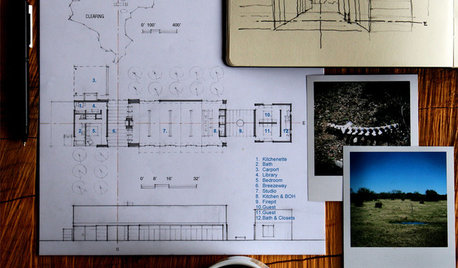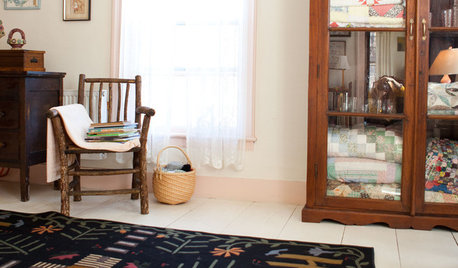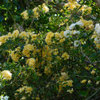This is a band sized plant of the rose Dr. E. M. Mills. It was delivered on July 25 in the condition shown below.
{{gwi:303895}}
My purpose is not to disparage the supplier as they have gone over and above everything to produce this difficult rose. It potentially contains genes of Rugosa, Spinosissima and Hugonis. I say "potentially" as the historical documentation of its breeding has been confused, but whatever is in it, Hugonis is definitely there, which is why I wanted it. The other two species are generally not happy in my soil, water and climate, but Hugonis is.
When I received it, I planted it in a one gallon can of Miracle Grow Moisture Control Potting Soil, containing both coir and time released fertilizer. I have kept it evenly moist to prevent any potentially excessive water stress.
Here it is today, 24 days later, being dutifully inspected by my "stalker".
{{gwi:303898}}]
In 24 days, the most actively growing shoot has grown 4.5". The chlorotic foliage is greening up well as shown below.
{{gwi:303901}}
{{gwi:303904}}
{{gwi:303907}}
{{gwi:303908}}
I presume this is closer to the "normal" foliage color as it was the darkest on the plant when received.
{{gwi:303910}}
Were I inclined to enthusiastic hyperbole, I might describe the results as "immediate". Were I not more of a "wait and see" type of gardener, I might have begun treating the plant for observed issues before seeing what it wanted to do in MY conditions. It IS improving itself. Why?
A band sized soil ball in a band pot is subject to much more extremely fluctuating temperature changes. A band sized soil ball encapsulated in a gallon sized soil ball is much more efficiently insulated against temperature fluctuations. A band sized soil ball has no where near the water holding capacity of a gallon chunk of soil. The medium it was received in was a mix of coarse perlite and coarse fir bark chunks, necessitated by the production requirements of the producer. They overhead water frequently (notice the calcium deposits on the foliage) to maintain actively growing plants, in small pots in order to minimize the area and water quantity required. When I transplanted the rose, the soil ball was only held together by the vigorous root system. It was spongy and attempted to break apart in my hand, requiring extra care to actually be able to insert it into the surrounding potting soil. The plant could then switch from "survival mode" to actually growing.
In the past 24 days, the weather here has changed dramatically from the late "June Gloom" with morning fog, cooler, damper daily conditions and overnight heavy dew to brilliant, breezy, fogless sun. The daytime temps have increased from the very low 80s to nearly triple digits.
The moisture control soil contains much more "organic material" than the propagation medium in which it was received does. Even though that medium is still inside the potting soil ball, the potting soil is not only releasing nutrients from its organic material being "digested" faster due to increased water and heat, but also from the more quickly deteriorating time released inorganic fertilizer it contains. The moisture levels the plant has at its disposal are significantly greater than those available in the much looser, smaller band medium ball.
There is obviously more nitrogen, iron and other necessary "nutrients" now available to the plant. It is also obvious the other causes of stress it endured in the propagation medium and band sized container are being alleviated by the soil and pot size changes.
Had I "treated" this plant with any other products or substances, how could I possibly have determined what changes were due to what? Plus, the plant is demonstrating it probably won't NEED anything else from me for the time being, other than to be kept watered, observed, and left alone to do its thing. Not every issue demands immediate addressing, nor does every issue require extreme measures to address. Kim

















Poorbutroserich Susan Nashville
roseseekOriginal Author
Related Discussions
New - Terraces and Tomatoes Revisited
Q
groundcovers revisited
Q
Childhood Memories
Q
Hachiya persimmon seedling
Q
roseblush1
kittymoonbeam
roseseekOriginal Author
catspa_NoCA_Z9_Sunset14
mendocino_rose
lou_texas
seil zone 6b MI
jerijen
kittymoonbeam
jerijen
roseseekOriginal Author
mendocino_rose
roseseekOriginal Author
bluegirl_gw
roseseekOriginal Author
Kippy
kittymoonbeam
roseseekOriginal Author